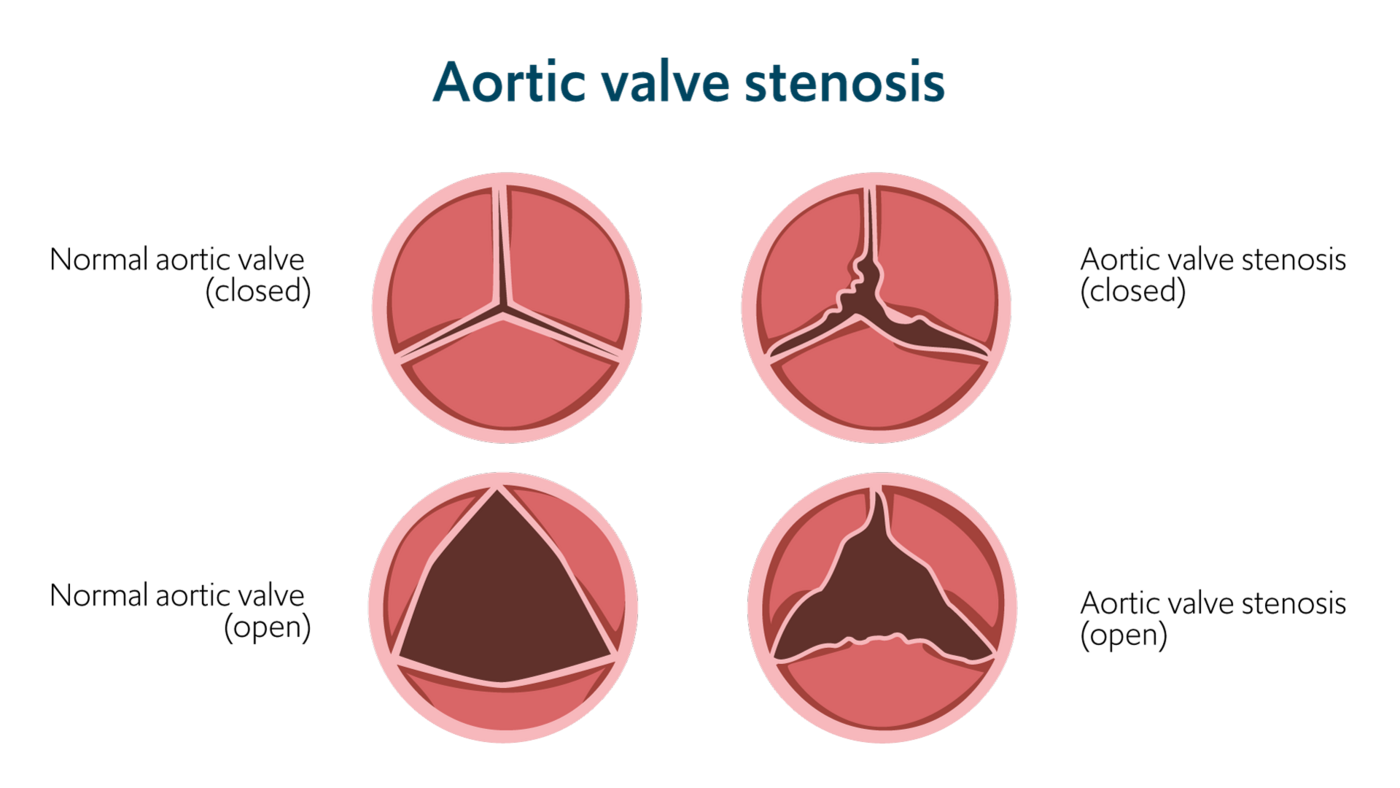What is aortic stenosis?
Aortic stenosis is the most common heart valve disease worldwide. It is a type of aortic valve disease in which the aortic valve leaflets become stiff, do not open properly and so the valve is narrowed. In aortic stenosis, the blood flow out of the heart’s main pumping chamber (the left ventricle) is obstructed, which causes uncomfortable symptoms including dizziness, fatigue, chest pain and breathlessness.
If untreated, aortic stenosis can reduce the blood flow through your body and cause serious complications, including heart failure, heart rhythm abnormalities, and death. Living with a heart valve problem can be worrying; however, medication can relieve some symptoms, and surgery can replace the diseased valve with an artificial valve and allow you to live an active, full and healthy life.
What is the aortic valve?
The aortic valve is one of the heart’s four valves that work to keep blood flowing in one direction through the heart. It comprises three tissue leaflets or flaps and is located on the left side of the heart between the left ventricle – the large, lower chamber which is the strongest pumping chamber – and the aorta, the largest artery that transports oxygen-rich blood to supply your body’s needs.

The aortic valve acts as a gateway, letting blood flow from the left ventricle into the aorta.
What does the aortic valve do?
“The aortic valve acts as a gateway, letting blood flow from the left ventricle into the aorta. It opens and closes as your heart beats,” explains consultant interventional cardiologist Dr Simon Davies.
A healthy aortic valve opens when your left ventricle pumps to allow blood to flow out of the heart and into the aorta. The aortic valve then closes to prevent blood from flowing backwards into the heart.
What is aortic stenosis?
Aortic stenosis is a common and serious valve problem. In aortic stenosis, the aortic valve is narrowed, restricting the blood flow from your left ventricle into the aorta.
Aortic stenosis can affect blood flow around your body and increase the pressure in the left atrium. Your heart must work harder to pump the blood and oxygen your body needs, which strains the organ. Aortic stenosis can progressively damage your heart and cause severe complications, including heart failure, cardiac arrhythmias and sudden death.

Aortic valve stenosis causes the valve to become narrowed, reducing blood flow through the heart.
Aortic stenosis causes
“The causes of aortic stenosis vary across the world. In North America and Europe, the most common cause is age-related stiffening due to calcium build-up on the aortic valve. However, in developing countries, damage by rheumatic fever following strep throat infection is more common. Streptococcal infections can trigger an immune reaction called rheumatic fever which inflames and scars the aortic valve, narrowing it and increasing the risk of calcium deposits,” says Dr Simon Davies.
Some people are born with an aortic valve with two, instead of three, tissue leaflets. These so-called bicuspid aortic valves make you more likely to get aortic stenosis, with around one in two people developing the condition before 50. Rarely, babies are born with their aortic valve leaflets stuck together, causing congenital aortic stenosis.
How common is aortic stenosis?
Aortic stenosis is a common problem in elderly individuals. More than one in eight people over 75 have moderate or severe aortic valve disease. The number of people living with aortic stenosis is predicted to increase two or three times in the coming decades as a result of the ageing population.
Aortic stenosis symptoms
Many people with the condition have no symptoms, especially in the early stages of aortic stenosis. However, as aortic stenosis progresses, the disease can cause some uncomfortable symptoms, including:
- feeling dizzy and lightheaded
- fatigue
- chest pain
- palpitations – a fast, fluttering heartbeat
- breathlessness on exertion
- feeling dizzy or lightheaded, even fainting
- progressive difficulties exercising and performing everyday activities
- ankle or foot swelling
- breathlessness when lying flat, needing to sleep sitting up
Aortic stenosis complications
When your aortic valve is narrowed, your heart’s left ventricle has to work harder to pump blood into the aorta. Over time the muscle in the ventricle thickens and gets stiffer. The pressure in the left side of the heart and lungs rises, and you are at risk of developing heart failure if the faulty valve isn’t replaced. Aortic stenosis complications include:
- atrial fibrillation: an irregular heart rhythm
- cardiac arrhythmias: abnormal heart rhythm disturbances which can cause sudden death
- pulmonary hypertension
- heart failure: if your heart fails, it can’t pump the blood your body needs. You will feel weak, tired and breathless. The fluid build-up causes foot and ankle swelling and lung congestion, which causes coughing and makes you breathless, especially when lying down
- endocarditis: a damaged or diseased aortic valve is at risk of endocarditis, a potentially serious valve inflammation
Aortic valve stenosis treatment
“Aortic valve stenosis treatment depends on the stage of your disease, your symptoms and your heart health,” explains Dr Simon Davies.
“Treatment should relieve symptoms, and allow you to function and live an active life. However, over time, aortic stenosis damages the heart.”
If your aortic stenosis is severe, medication will not be able to relieve symptoms and keep your heart working well. However, surgery to replace the valve can slow down or even reverse heart failure and allow you to live a normal and fulfilling life. Treatments include:
- medication
- surgical aortic valve replacement
- transcatheter aortic valve implantation or TAVI
Medication to treat aortic stenosis symptoms
Drugs can treat some aortic stenosis symptoms, but they cannot relieve or reverse the underlying valve narrowing itself. Treatments include:
- rhythm drugs for atrial fibrillation
- diuretics to reduce excess fluid and treat lung congestion and breathlessness
- hypertension medications to control blood pressure
- anticoagulants to prevent clotting
Surgical aortic valve replacement
The definitive treatment for aortic stenosis is surgical valve replacement. It is open-heart surgery to remove the damaged or diseased valve and replace it with a prosthetic valve. Aortic valve replacement prolongs life and improves the quality of life. Even in elderly patients over the age of 80 years, studies show that outcomes are excellent in patients after surgery to replace their aortic valve.
Transcatheter aortic valve implantation or TAVI
TAVI is an innovative, minimally-invasive procedure to treat aortic stenosis. The cardiologist inserts a new valve into your heart through a blood vessel in your groin, shoulder or arm. They place a prosthetic animal-tissue device within your existing aortic valve. It flattens and pushes the damaged valve out of the way and takes over its function.
TAVI is a less invasive alternative to open-heart surgery and is currently used for people who are too frail or unwell for invasive surgery. However, NICE (National Institute for Health and Care Excellence) is reviewing its TAVI guidelines. It may recommend the procedure for people who are only at intermediate or low risk for cardiac surgery.
For more information, please read our article on ‘What is TAVI?‘
Balloon valvuloplasty
Valvuloplasty is a minimally invasive procedure that can stretch the aortic valve and increase blood flow. It is used to relieve congenital aortic stenosis in children and young adults. The cardiologist introduces a fine, flexible tube into a blood vessel in the groin. They pass the catheter to the heart using X-ray guidance, then inflate a balloon within the valve, stretching and opening it up to improve blood flow. This is much quicker than TAVI, but often the narrowing returns after 6 months, so TAVI is a better procedure in the long term.
Contact us
To book an appointment, or for more information please contact our customer care team.
